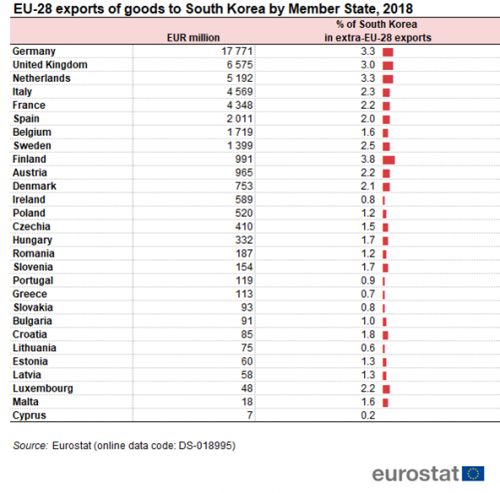Archive:South Korea-EU - international trade in goods statistics
Data extracted in Februaria 2019.
Planned article update: Februari 2020.
Highlights
In 2018, among the EU's trading partners, South Korea was the eighth largest partner for both exports and imports of goods.
Manufactured goods dominate EU exports to South Korea and EU imports from South Korea.
Imports, exports and trade balance in goods between the EU and South Korea, 2008-2017
This article provides a picture of the international trade in goods between the European Union (EU) and South Korea. It analyses the type of goods exchanged between the two economies and the shares of each EU Member State in those exchanges.
This article is part of an online publication providing recent statistics on international trade in goods, covering information on the EU's main partners, main products traded, specific characteristics of trade as well as background information.
Full article
General overview
- In 2017, South Korea was the fifth largest exporter of goods and sixth largest importer of goods in the world with a share of 4.1 % of world exports and a share of 3.4 % of world imports.
- In 2018, among the EU's trading partners, South Korea was the eighth largest partner for both exports and imports of goods.
- EU trade in goods deficit with South Korea reduced from a EUR 14.0 billion in 2008 to only EUR 1.9 billion euro in 2018.
- Manufactured goods have a share of 88 % of EU exports of goods to South Korea and 94 % of EU imports of goods from South Korea.
- Among EU Member States, Germany is the largest importer of goods (EUR 9.2 billion) from and exporter of goods (EUR 17.8 billion) to South Korea.
- Germany has the largest trade in goods surplus (EUR 8.6 billion) with South Korea while Slovakia (EUR 3.6 billion) has the largest trade in goods deficit.
EU and South Korea in world trade in goods
Figure 1a shows that the four largest exporters of goods accounted for almost half of the world's exports. The largest is China (16 %) followed by the EU (15 %), the United States (11 %) and Japan (5 %). The same four accounted also for almost half of the world imports of goods but in different order. Here the United States (18 %) leads, followed by the EU (15 %), China (12 %) and Japan (5 %).
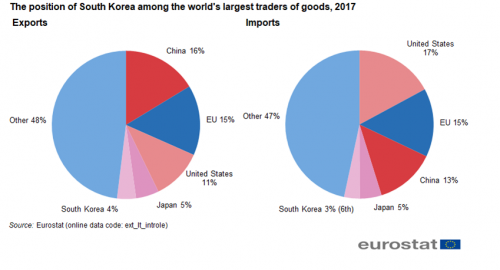
Source: Eurostat (ext_lt_introle)
Figure 1b has some more details showing that South Korea is the fifth largest exporter of goods (EUR 508 billion, 4.1 %) between Japan (EUR 618 billion) and Hong Kong (EUR 487 billion). South Korea is the sixth largest importer of goods (EUR 424 billion, 3.4 %) in the world between Hong Kong (EUR 522 billion) and India (EUR 393 billion).

Source: Eurostat (ext_lt_introle)
Figure 2 focuses on the evolution of trade of goods in the EU and South Korea over the period 2007-2016. From 2007 to 2011 imports and exports (both indexed at 100 % in 2007) for both economies developed in similar fashion with a low point in 2009 followed by a recovery in which both exports and imports of South Korea grew more than those of the EU. For both economies exports continued to grow but after 2012 imports remained more or less constant or even fell in some years. This means that the cover ratio (exports divided by imports) of both economies increased. For the EU it passed the 100 % mark in 2013 and has remained just above it since then. For South Korea, except in 2008, it has always been above 100 % and in 2018 stood at 120 %. In 2016 both South Korean exports and imports fell ten percentage points but both grew by 22 percentage points in 2017.
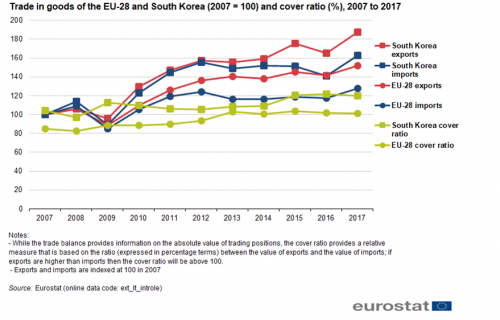
Source: Eurostat (ext_lt_introle)
Record growth of EU imports of goods from South Korea in 2017
Figure 3a shows South Korea's trade of goods compared to the top four trading partners of the EU which were the United States, China, Switzerland and Russia. These four made up 44 % of all exports from the EU and 47 % of all imports to the EU.
Figure 3b has some more details and shows that in 2017, South Korea was the EU's eighth largest partner for exports of goods (EUR 50 billion, 2.7 %) between Norway (EUR 541 billion, 2.8 %) and India (EUR 46 billion, 2.3 %). For imports of goods it was also the EU's eighth largest partner (EUR 51 billion, 2.6 %) at some distance behind Japan (EUR 70 billion, 3.6 %) and before India (EUR 46 billion, 2.3%).
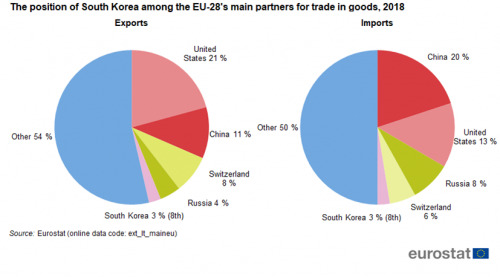
Source: Eurostat (ext_lt_maineu)
[[Image:Top 20 import and export partners for trade of goods of the EU with a focus on South Korea, 2018 .png |thumb|center|500px|Figure 3b: Top 20 import and export partners for trade of goods of the EU with a focus on South Korea, 2018
Source: Eurostat (ext_lt_maineu)]]
The EU recorded a trade in goods deficit with South Korea from 2008 to 2012 (see Figure 4). In this time span, trade between the two economies hit a low in 2009. Exports quickly recovered and except for 2016 continued to grow to a record height of EUR 50 billion in 2017, dropping slightly in 2018 to EUR 49 billion. Imports also recovered, their growth was very small and uneven reaching EUR 42 billion in 2015 and 2016. However from 2016 to 2017 there was a strong increase of more than EUR 10 billion to a record height of EUR 52 billion which dropped to EUR 51 billion in 2018. Consequently, the trade surplus that the EU had since 2013 turned into a small deficit of EUR 1.9 billion in 2018 which was much less than the EUR 14.2 billion it had been ten years earlier.
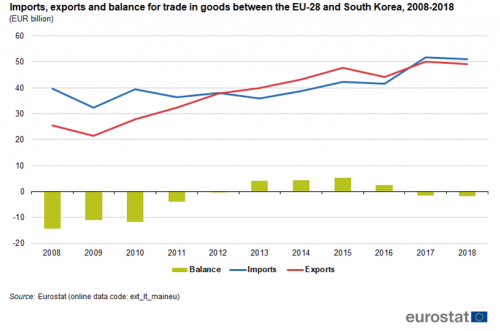
Source: Eurostat (ext_lt_maineu)
Manufactured goods dominate trade with South Korea
When breaking down imports and exports by SITC groups, the main categories driving the exports to South Korea are 'Machinery and vehicles' (48 %), 'Other manufactured goods' (23 %) and 'Chemicals' (17 %) (see Figure 5). Together these manufactured goods accounted for 88 % of EU exports. Manufactured goods dominated imports even more, with a share of 94 % in 2018. Here too 'Machinery and vehicles' (72 %) was the largest group, followed by 'Other manufactured goods'(17%) and 'Chemicals' (4 %). Between 2008 and 2018 the shares of the different product groups in exports changed very little. In contrast, in imports the share for 'Machinery and vehicles' increased by almost ten percentage points while 'Chemicals' decreased by almost ten percentage points.
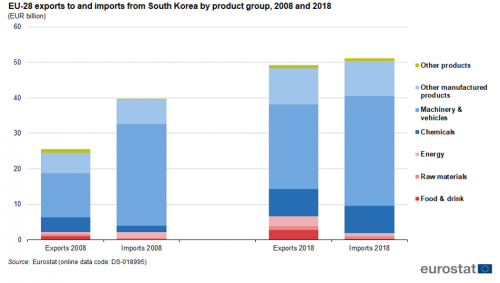
Source: Eurostat DS-018995
Figure 6 shows the evolution of EU imports and exports by SITC group since 2007. In 2018 the EU had small trade surpluses in all groups except in 'Machinery and vehicles' and 'Other goods' with deficits of EUR 7.2 billion and 0.1 respectively. Although 'Machinery and vehicles' had the largest deficit in 2018 it was much less than the EUR 16.4 billion it had been in 2008.
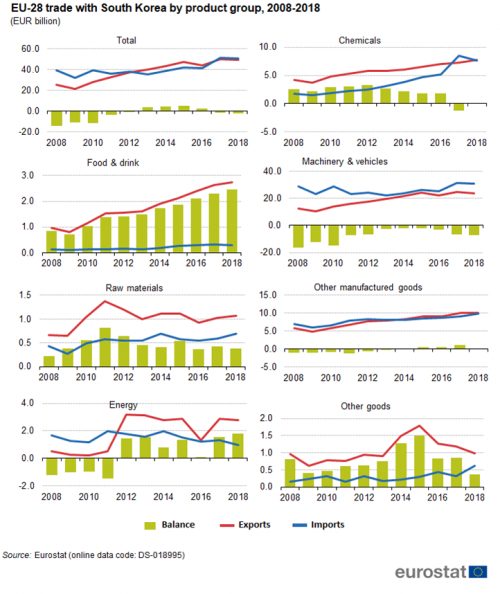
Source: Eurostat DS-018995
Most traded goods: cars
Figure 7 gives more detail about the goods exchanged between the EU and South Korea, showing the top 20 traded goods at a more detailed level (by SITC level 3). Those top 20 goods covered 55 % of total traded goods in 2018. The top fiveproducts all belonged to the 'Machinery & vehicles' group which had a total of 13 products in the top 20. 'Chemicals' had four products in the top 20. The three remaining products were petroleum oils (both crude and non-crude) and measuring and other instruments. At this product level motor cars and vehicles were both the most imported and most exported product between the EU and South Korea.
Another interesting way to look at data is to investigate the export/import ratio of traded goods, in order to better identify the direction taken by flows and specialisation between the two areas. These ratios can be found in the right-hand margin of Figure 7. For the top product 'motor cars and motor vehicles' the cover ratio of 97 indicates that trade flows are fairly balanced with just a little less exports than imports. The second most trades product, 'other machinery' had a ratio of 326 meaning that exports to South Korea were more than three times as high as imports from South Korea. The opposite was true for the third most traded product which was 'motor vehicle parts'. The lowest ratio of only 1% was found for ships boats and floating structures.
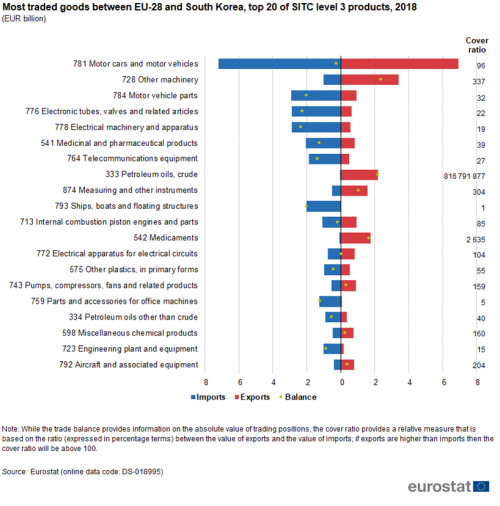
Source: Eurostat DS-018995
Germany and the United Kingdom trade most with South Korea
Figure 8a shows Member States' imports of goods from South Korea and the share of the partner South Korea in national extra-EU imports of goods in 2018. Table 8b provides similar information but concerning Member States' exports of goods to South Korea.
There were three Member States whose imports of goods from South Korea were higher than EUR 4 billion: Germany (9.2 billion), the Netherlands (EUR 5.9 billion), the United Kingdom (EUR 4.5 billion) and Italy (EUR 4.1 billion). South Korea is an important partner for Slovakia (23 % of extra-EU imports of goods) and Cyprus (17 %). The share is below 10 % for the other Member States.
Germany (17.8 billion), the United Kingdom (EUR 6.6 billion) and the Netherlands (EUR 5.1 billion) and Italy (EUR 4.6 billion) are also the largest exporters of goods to South Korea, while France (EUR 4.3 billion) also had exports of more than EUR 4 billion. Only Finland (3.8 %), Germany (3.3 %), the Netherlands (3.2 %), and the United Kingdom (both 3.0 %) had more than 3 % of their extra-EU exports of goods destined for South Korea in 2018.
Figure 8c shows that 10 Member States had a trade in goods surplus with South Korea in 2018, ranging from just EUR 5 million for Luxembourg to EUR 8.6 billion for Germany. The United Kingdom (EUR 2.0 billion) and France (EUR 1.4 billion) were the only other countries whose trade surplus was larger than EUR 1 billion. The remaining 18 Member States had a trade in goods deficit, starting at EUR 2 million for Estonia to EUR 3.6 billion for Slovakia. Poland (EUR 2.6 billion), the Czechia (EUR 2.1 billion), Hungary (EUR 1.7 billion), and Slovenia (EUR 1.0 billion) were the only other countries whose trade deficit with South Korea was larger than EUR 1 billion.
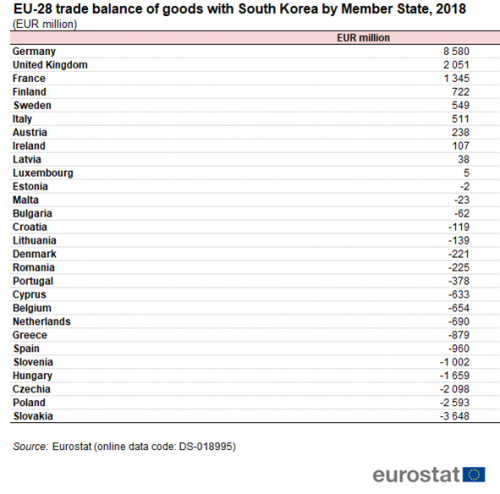
Source: Eurostat DS-018995
Source data for tables and graphs
Data sources
EU data is taken from Eurostat's COMEXT database. COMEXT is the reference database for international trade in goods. It provides access not only to both recent and historical data from the EU Member States but also to statistics
of a significant number of third countries. International trade aggregated and detailed statistics disseminated via the Eurostat website are compiled from COMEXT data according to a monthly process.
Data are collected by the competent national authorities of the Member States and compiled according to a harmonised methodology established by EU regulations before transmission to Eurostat. For extra-EU trade, the statistical information is mainly provided by the traders
on the basis of customs declarations.
EU data are compiled according to Community guidelines and may, therefore, differ from national data published by the Member States. Statistics on extra-EU trade are calculated as the sum of trade of each of the 28 EU Member States with countries outside the EU. In other
words, the EU is considered as a single trading entity and trade flows are measured into and out of the area, but not within it.
Data for the other major traders are taken from the Comtrade database of the United Nations. Data availability differs among countries, therefore Figure 1 shows the latest common available year for all the main traders. For the calculation of shares the world trade is defined as
the sum of EU trade with non-EU countries (source: Eurostat) plus the international trade of non-EU countries (source: IMF Dots database).
Methodology
According to the EU concepts and definitions, extra-EU trade statistics (trade between EU Member States and non-EU countries) do not record exchanges involving goods in transit, placed in a customs warehouse or given temporary admission (for trade fairs, temporary
exhibitions, tests, etc.). This is known as ‘special trade’. The partner is the country of final destination of the goods for exports and the country of origin for imports.
Product classification
Information on commodities exported and imported is presented according to the Standard international trade classification (SITC). A full description is available from Eurostat’s classification server
Unit of measure
Trade values are expressed in millions or billions (109) of euros. They correspond to the statistical value, i.e. to the amount which would be invoiced in the event of sale or purchase at the national border of the reporting country. It is called a FOBvalue (free on board) for exports and a CIF value (cost, insurance, freight) for imports.
Context
Trade is an important indicator of Europe’s prosperity and place in the world. The bloc is deeply integrated into global markets both for the products it sources and the exports it sells. The EU trade policy is an important element of the external dimension of the ‘Europe 2020
strategy for smart, sustainable and inclusive growth’ and is one of the main pillars of the EU’s relations with the rest of the world.
Because the 28 EU Member States share a single market and a single external border, they also have a single trade policy. EU Member States speak and negotiate collectively, both in the World Trade Organization, where the rules of
international trade are agreed and enforced, and with individual trading partners. This common policy enables them to speak with one voice in trade negotiations, maximising their impact in such negotiations. This is even more important in a globalised world in which
economies tend to cluster together in regional groups.
The openness of the EU’s trade regime has meant that the EU is the biggest player on the global trading scene and remains a good region to do business with. Thanks to the ease of modern transport and communications, it is now easier to produce, buy and sell goods
around the world which gives European companies of every size the potential to trade outside Europe.
Direct access to
- International trade in goods (t_ext_go), see:
- International trade in goods - long-term indicators (t_ext_go_lti)
- International trade in goods - short-term indicators (t_ext_go_sti)
- International trade in goods (ext_go), see:
- International trade in goods - aggregated data (ext_go_agg)
- International trade in goods - long-term indicators (ext_go_lti)
- International trade in goods - short-term indicators (ext_go_sti)
- International trade in goods - detailed data (detail)
- EU trade since 1988 by SITC (DS-018995)
- International trade in goods statistics - background
- International trade in goods (ESMS metadata file — ext_go_esms)
- User guide on European statistics on international trade in goods

